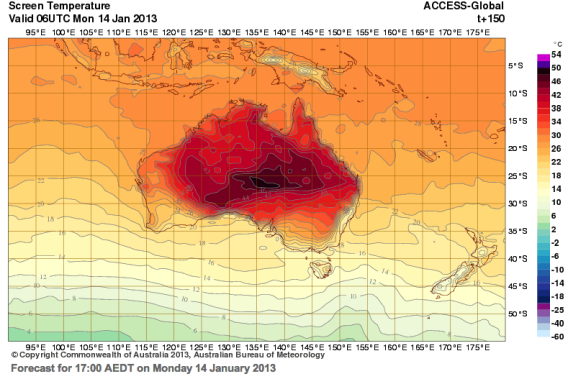The last four months of 2012 were the hottest on record in Australia. But January is shaping up to be even hotter.
Between Jan. 3 and Jan. 6, an amazing 18 different weather stations recorded all-time temperature highs, according to a special climate statement from the country’s Bureau of Meteorology. Those included a mark of 118 degrees in Eucla, Western Australia, and an unheard-of 107 in Hobart, Tasmania, which bills itself as the gateway to Antarctica.
But the bureau’s forecasters believe the worst is yet to come—which is why they’ve added a new color to their official weather maps, for temperatures up to 54 degrees Celsius (129 Fahrenheit). In other words, they believe the country’s all-time high temperature of 123 degrees, set in 1960, is about to go down, and hard.
Earlier today, the Sydney Morning Herald grabbed a screenshot of an official weather prediction map that showed a splotch of shocking purple over South Australia, the brand-new indicator for temperatures in excess of 50 Celsius (122 Fahrenheit). It appears the bureau has since eased its predictions for Monday, as the purple has receded for the time being. But the new color lives on in the temperature index to the right of the maps, reflecting a new climate reality in which a 129-degree day would no longer be off the charts.
Meanwhile, the country’s fire danger levels have been elevated to “catastrophic,” with over 100 blazes already burning in its most populous state, New South Wales.
Of course, it isn’t just Australia that’s getting toastier these days. After Europe’s 2003 and 2010 heat waves broke 500-year seasonal average temperature records, researchers predicted in the journal Science that such “mega-heatwaves” would become five to 10 times more common on the continent in the decades to come.
Here in the United States, July marked the hottest month on record, surpassing the worst of the 1936 Dust Bowl, and the corresponding drought took a significant toll on the country’s overall economic growth. On Tuesday, the National Oceanic and Atmospheric Administration announced that 2012 was the hottest year on record by a full degree.
Welcome to the 21st Century. It’s gonna be a scorcher.
